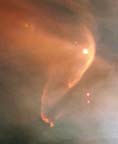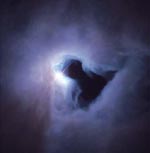Star Formation
Stars form in dense molecular clouds within galaxies. These clouds of dust and gas obscure the early stages of stellar formation from optical telescopes. Fortunately recent advances in radio and infrared astronomy now allow astronomers to peer inside these clouds and gain a greater understanding of the processes involved in starbirth. Computationally intensive computer simulations also allow them to model the processes and test the results against observations.
Gravity is the force responsible for stellar formation and the mass of material that forms at star largely determines its life and fate.
The Interstellar Medium & Nebulae
Nebulae are simply clouds of interstellar gas and dust and appear either as dark regions blotting out background stars - the so-called dark or absorption nebulae or as brighter clouds of gas that emit or reflect light. They are the most visible components of the interstellar medium.
The Interstellar Medium
Despite what you might think, space is not a perfect vacuum. The space between the stars is filled with a tenuous range of material that provides the building blocks of stars. This material is gas and dust and collectively is known as the interstellar medium (ISM). The ISM gas is predominantly hydrogen whilst the dust is about 1% by mass and includes carbon compounds and silicates. Dust is responsible for the interstellar reddening and extinction of starlight. The more of the ISM a star's light travels through on its way to an observer on Earth the more it gets scattered and absorbed, decreasing the star's apparent brightness and reddening its appearance.
Properties of the ISM vary widely depending upon its location within a galaxy. At its most tenuous, in hot regions between denser clouds, it may have a density of only 100 particles per cubic metre, mostly ionised hydrogen atoms. In the inner regions of shells of gas surrounding stars the density can be as high as 1017 particles per m3 although this is still a million times less dense than a normal vacuum on Earth.
Giant Molecular Clouds (GMCs) & Absorption Nebulae
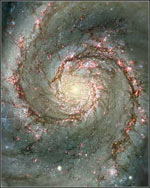
Stars form in regions of the ISM where there is sufficient material available. These are the giant molecular clouds or GMCs. The GMCs contain large amounts of matter; 105 to 2 × 106 solar masses from 12 to 120 pc across and are very cold, typically only 10 -30 K. Their main constituent is molecular hydrogen gas but other molecules such as water, carbon monoxide, CO, ammonia, NH3 and methanol, CH3OH are also present. Although denser than most of the ISM they still only have a few hundred hydrogen molecules per cubic centimetre making them 1017 × less dense than our atmosphere. The dust within these clouds is sufficient to block out starlight from stars and thus also keeps the cloud temperature very cold. Dust grains are roughly 30 nm in size although they may also have a mantle of ice or frozen ammonia on them, increasing their size tenfold. One of our best methods of studying these clouds is by the characteristic emissions from CO molecules at mm wavelengths in the radio waveband.
In spiral galaxies such as our own Milky Way the GMCs tend to be concentrated along the spiral arms and can be seen as the dark dust bands in the arms. We see some of the closer dense molecular clouds as absorption or dark nebulae. Examples include the Coalsack Nebula in Crux and the famous Horsehead Nebula in Orion. Dark nebulae are often alongside hotter regions where the radiation from nearby stars is already heating the gas so that it glows. These are emission regions.
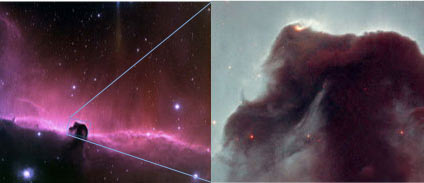
Emission Nebulae
An emission nebula is a cloud of dust and gas that shines due to the emission of its own light. Gas is these nebulae is hot enough to be ionised and the emitted light is due to interactions between the free electrons and the ions and to electron transitions within ions. Actually there are three main types of emission nebulae; HII regions associated with starbirth regions such as M42, the Great Nebula in Orion, planetary nebulae associated with the death of lower-mass stars and supernova remnants (SNRs). These later two are discussed elsewhere. Here we focus on the HII starbirth regions.
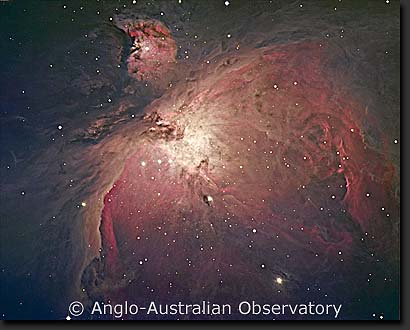
In astronomy, HI refers to neutral hydrogen whilst HII is ionised hydrogen. HII regions generally display distinctive red and green colours.The red is caused by hydrogen-alpha emission and forbidden transitions of singly-ionised nitrogen. OIII, doubly-ionised oxygen ions in which both the outer electrons have been lost, produces a green emission due to forbidden transitions. This process only takes place if photons have high enough energy such as the UV photons emitted from hot O and B stars within or close to the nebula.
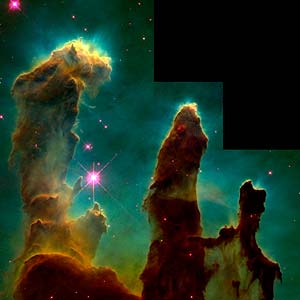
The intense radiation released by these hot, young stars eventually sweeps away the dust and gas, leaving the stars exposed.
Reflection Nebulae
Reflection nebulae are much less dense than emission nebulae. They appear bluish due to the dust grains preferentially scattering blue light from nearby hot stars. Our sky appears blue for much the same reason, blue light from the Sun is scattered in all directions. The scattering of light also polarises it, a fact astronomers utilise to study the properties of the dust.
Different types of nebulae are often found close together. Just as absorption and emission nebulae may be associated, the regions further out from hot stars may appear as reflection nebulae. Clusters of stars that are still relatively young may be old enough to have dispersed most of the surrounding dust and gas but still have traces left as a reflection nebula. A classic example of this is the blue nebulosity seen around the Pleiades.
Protostars
Protostars form when sections of giant molecular clouds start to collapse. Clouds are initially diffuse enough that they do not contract unless something triggers an increase in the density of some regions within a cloud. There are several possible causes that include:
- The expanding shock front from a nearby supernovae sweeps up the local ISM and compresses it. As the front passes through a cloud it causes irregularities and local regions of higher density that may then collapse.
- Spiral galaxies rotate without their arms "winding up". This is due to a spiral density wave that sweeps around the plane of the galaxy, compressing the material in its path including clouds of dust and gas. This helps account for the observed star formation in spiral arms.
- Stars and clouds are not fixed in place, as they move they may pass near another cloud, triggering gravitational collapse due to variations in density.
- Regions with a number of young, hot O and B-class stars (called OB Associations) produce large amounts of visible and ultraviolet radiation that compress the ISM due to radiation pressure.
The gravitational collapse of a GMC does not result in a single, massive star. Instead the cloud tends to fragment into smaller denser regions that each collapse to form star systems. Up to a few thousand stars may typically form in a collapsing GMC resulting in an open (or galactic) cluster.
The dense regions collapse due to gravitational attraction between the particles. Individual gas or dust particles move in towards the centre of the collapsing region, losing gravitational potential energy. As the total energy of the system is conserved the loss of gravitational energy is balanced by an increase in the kinetic energy of the particles. These particles then undergo more collisions which in turn raises the temperature of the gas. At this stage further collapse is only possible if the cloud can radiate away the thermal energy so that the radiation pressure outwards remains lower than the inward gravitational pull. This is achieved via convection cycling warm material upwards within the cloud, making the collapsing cloud visible in the infrared region.
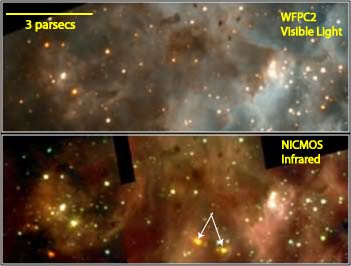
Continued collapse leads to higher densities so that eventually the cloud becomes opaque, trapping the thermal energy within the cloud. This then causes both the temperature and pressure to rise rapidly - the collapsing cloud is now a protostar. The timescale for this is basically a function of the mass of the collapsing cloud with more massive clouds collapsing more rapidly into a protostar. A 15 solar mass protostar may collapse in only 105 years whilst a star like our Sun would take around 50 million years. Low mass stars may take twice as long meaning that within a cluster the most massive stars have collapsed onto the main sequence, evolved off it and ended their "lives" before a 1/2 solar mass star has even made it onto the main sequence.
As the collapse of a protostar is shrouded in obscuring dust and gas clouds observations need to take place in the infrared and radio regions. Our models of the processes continue to be refined but theoretical evolutionary tracks of this stage, called Hayashi or Pre-main sequence (PMS) tracks, can be shown an an H-R diagram. Four of these are shown on the diagram below, with that for a one solar mass star explained in more detail following the diagram.
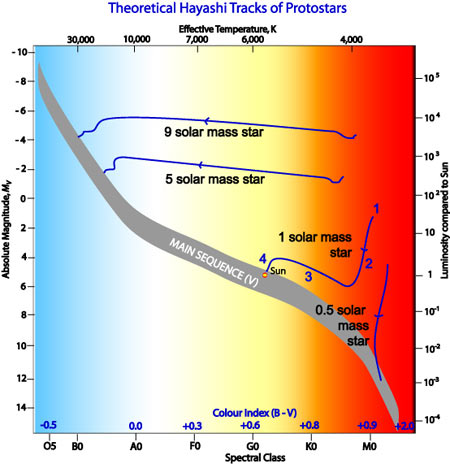
Stages in the formation of a 1 solar mass star:
- Initial collapse of a cloud causes it to heat up and become a protostar. Although cool it is very large, perhaps 20 × the diameter of the Sun, thus its surface area is so great that its overall luminosity is very high, maybe 100 × its main sequence luminosity.
- As it radiates away energy, gravitational collapse pulls the protostar inwards rapidly. Its temperature rises but this is offset by the decrease in size so that overall luminosity decreases significantly as shown by the vertical drop on the H-R diagram.
- Once the core temperature reaches 10 million K, coulombic repulsion between the now ionised hydrogen atoms (protons) is overcome and nuclear fusion commences. Hydrogen fuses to form helium nuclei, releasing energy in the process. Initially the increased outward radiation pressure is still insufficient to halt gravitational collapse but it does slow it down. The star's surface temperature increases significantly, compensating for the drop in size so that its luminosity increases slightly. The star's track moves up slightly and to the left on the H-R diagram over 10 million years.
- As the rate of core fusion increases due to higher core temperature, the outward gas and radiation pressures eventually match the inward gravitational force. The star attains a state of hydrostatic equilibrium and settles down onto the main sequence. This stage may take a few tens of million years.
As you can see from the Hayashi tracks for stars of other masses, their evolutionary paths are different. Again the key factor is the mass of the protostar. In general more massive stars collapse and thus heat up more quickly so core fusion starts much sooner. Their luminosity remains essentially constant so they evolve almost horizontally across the H-R diagram. Low mass stars such as the 0.5 solar mass protostar can only transport energy from the core by convection. The decrease in the radius of such protostars as they collapse is more important than the increase in surface temperature so their luminosities drop as they move down onto the main sequence.
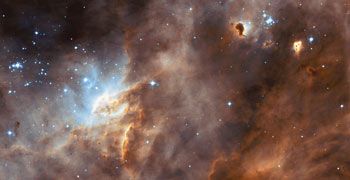
T Tauri Stars
T Tauri stars are young, irregular, variable stars. They are protostars of 3 solar masses or less, still collapsing and undergoing mass-loss. This material is ejected into space at speeds up to 500,000 km h-1 at a rate of 10-7 to 10-8 solar masses per year. The T Tauri phase may last 10 million years during which a mass equal to the Sun is ejected. Spectral analysis shows that these stars rotate rapidly and have high abundances of lithium, an element that is consumed early in a star's life. They are located just to the right of the main sequence on an HR diagram.
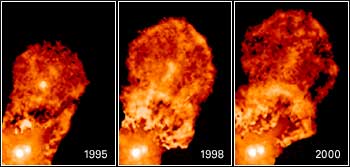
The early phases of a star's formation end when the temperature within its core is high enough for hydrogen nuclei (protons) to fuse together. This initiation of so-called hydrogen-burning marks the star's transition onto the main sequence, the next stage of its existence.

